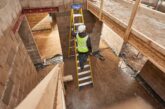
Professional Builder puts the questions to the Ladder Association’s Executive Director, Peter Bennett on what the organisation is doing to promote safe working at height.
Professional Builder (PB): Tell us about the Ladder Association and what the organisation hopes to achieve?
Peter Bennett: The Ladder Association is a not-for-profit organisation that provides simple, practical and free guidance to help make sure everyone who climbs a ladder comes back down safely. Last year we celebrated our 75th anniversary and have over 80 members, including manufacturers, suppliers, and training centres.
PB: Can you give us some insight into the scale of the problem when it comes to safety issues when working at height?
Peter: According to the latest HSE statistics for 2022-2023, over 5,000 people in Great Britain were injured at work due to a fall from height. Sadly, 40 also lost their lives.
At the same time, we know there is substantial underreporting of non-fatal falls from height, but particularly amongst the self-employed micro businesses. Indeed, HSE found that these groups report just 12 per cent of workplace incidents. According to the Labour Force survey – which is an alternative data source – the number of falls from height over the last 10 years may be as much as 425,000.

That’s corroborated by hospital data from Scotland, England and Wales, which shows that almost 8,000 people each year find themselves in hospital after falling on or from a ladder. 91 per cent of those are emergencies into A&E and the average time in hospital for those admitted is two to four days.
Aside from the obvious physical consequences, if you’re self-employed, or a small business owner, that time off work can have a considerable impact on your livelihood and finances.
PB: Do you think there’s a particular problem with working at height and complying with regulations amongst local, jobbing builders?
Peter: The construction sector consistently accounts for the largest number of fatalities of workers in general – 45 out of 135 workplace deaths in 2022-23, in fact. As well as that, almost two thirds – 25 out of 40 – of falls from height fatalities in 2022-23 occurred in the building industry.
There is an assumption that, when it comes to ladders, there’s not a lot to know, and unfortunately that makes them amongst the most misused classes of equipment across companies of all sizes. Ladders are readily available, and usually there’s one in the back of a builder’s van. They can certainly be a sensible and practical option for low risk and short duration tasks but that doesn’t mean they should automatically be your first choice.
We do know that time and money pressures, particularly in small businesses, are ever present. And of course, there’s the general belief that we hear time and time again – “it’ll never happen to me”.
PB: Are there some simple steps that tradespeople can follow to stay safe?
Peter: Make sure you’ve planned the work properly to mitigate and to assess any risks. You should be trained to use the equipment and, if you’re not, this can be undertaken at a Ladder Association training centre. If you think the equipment, the job or anything about what you’re doing is unsafe, stop work.

I know that can be a difficult thing to do when the job needs doing, but the number of people we’ve spoken to who say if only I’d done this or that. With your family waiting for you to come home safely it’s never worth the risk.
PB: The Ladder Association has done some very good work in reporting on the issue of non-compliant ladders, particularly items being sold online. Can you give us an indication of the scale of the dangers?
Peter: The Ladder Association has been highlighting the very serious issue of the availability and use of substandard – particularly imported – ladders in the UK market for many years.
Our own study revealed that over 80 per cent of the telescopic ladders that we tested failed to meet the minimum safety requirements designed to keep users safe. When we retested a proportion of those in 2023 every single set failed. In the late 2023, we tested the top 10 multipurpose ladders found via Google search and 70 per cent of the multipurpose ladders tested failed as well.
PB: What can builders do to make sure they’re purchasing ladders that are fit for purpose?
Peter: Undertake some research before you buy. Check the reviews but be aware of potentially fake reviews. Don’t purchase just on price or assume that products on the internet are safe. Online platforms can sell anything from anywhere in the world often with little or no checks. Avoid ladders that claim to be CE or UKCA marked because these regulations don’t cover ladders. Verify the certification and ask for a copy of the documentation that proves the equipment has been tested independently to EN 131, the product standard for ladders. And of course, one of the easiest ways for you to make sure all of the above is in place is to buy from a Ladder Association member.
PB: Can you tell us about the training courses you run?
Peter: The Ladder Association administers the leading ladder training scheme through a network of approved training centres. One of the most difficult things that we’ve had to try and overcome as an organisation in the last 10, 15 years is to persuade users and managers of those who work at height that people should be trained to use ladders.
Training is about more than just climbing a ladder. It’s about assessing the risks and identifying when it’s right to use one and, more importantly, when it’s not. You should be able to demonstrate an understanding of the correct ladder to use and how to use it.
Ultimately, our advice is quite clear. Make sure it’s right to use a ladder, make sure you use the right ladder, and make sure that you’re trained to use it safely.
For further information on the Ladder Association visit https://ladderassociation.org.uk/







